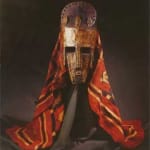Marka Brass and Wood Mask with Coloured Cloth, 19th Century CE - 20th Century CE
Wood brass & textile
14
PF.3240 (LSO)
This exotic metal and wood mask with textile train was made by the Marka (or Warka) people of Mali. It is reminiscent of Bambara/Bamana models, but differs in the rendering...
This exotic metal and wood mask with textile train was made by the Marka (or Warka) people of Mali. It is reminiscent of Bambara/Bamana models, but differs in the rendering of the facial features. The basic design is a metallic inverted triangle, the lower end removed to provide a square chin. The brow is prominent and angular along the tops of the eyes, resulting in a helmet-like appearance which is heightened by the high relief of the nose, which is long and divides the recessed face in half, and the flaps that hang down beside the temples on either side. The apex of the mask is crowned with three brass leaf-shaped decorations, positioned centrally and to each side, behind which there is a large (iron?) disc surrounded with perforations. The whole mask is attached to a large, predominantly red textile with geometric and figurative designs.
The Marka (or Maraca, or Warka) are a comparatively understudied group from NW Mali. Their nearest neighbours are the Bambara/Bamana, the Soninke and the Bozo, with which they have a great deal in common, which displaying certain cultural characteristics that mark them out. Part of this is attributable to their history: they were once exceedingly powerful due to their control of important trade routes across the Sahara, and demanding tribute from travellers. Their subsequent (early 19th century) alliance with the Bambara/Bamana proved to be disastrous when the latter was defeated by Islamic groups from the north, with which the Marka were technically aligned but had ignored in favour of economic security. The result was notable marginalisation, from which stems much of their individuality. They are particularly noted for their puppet shows (as are the Bozo) and for their masks, which bear similarity to Bambara models but tend to be possess more rounded features. They were used for various ceremonies, as well as for entertainment.
This is a dynamic and impressive piece of African art.
The Marka (or Maraca, or Warka) are a comparatively understudied group from NW Mali. Their nearest neighbours are the Bambara/Bamana, the Soninke and the Bozo, with which they have a great deal in common, which displaying certain cultural characteristics that mark them out. Part of this is attributable to their history: they were once exceedingly powerful due to their control of important trade routes across the Sahara, and demanding tribute from travellers. Their subsequent (early 19th century) alliance with the Bambara/Bamana proved to be disastrous when the latter was defeated by Islamic groups from the north, with which the Marka were technically aligned but had ignored in favour of economic security. The result was notable marginalisation, from which stems much of their individuality. They are particularly noted for their puppet shows (as are the Bozo) and for their masks, which bear similarity to Bambara models but tend to be possess more rounded features. They were used for various ceremonies, as well as for entertainment.
This is a dynamic and impressive piece of African art.
Literature
V19



